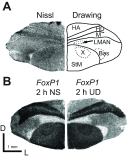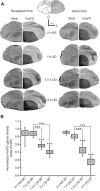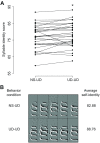Expression analysis of the speech-related genes FoxP1 and FoxP2 and their relation to singing behavior in two songbird species
- PMID: 24006346
- PMCID: PMC3763803
- DOI: 10.1242/jeb.085886
Expression analysis of the speech-related genes FoxP1 and FoxP2 and their relation to singing behavior in two songbird species
Abstract
Humans and songbirds are among the rare animal groups that exhibit socially learned vocalizations: speech and song, respectively. These vocal-learning capacities share a reliance on audition and cortico-basal ganglia circuitry, as well as neurogenetic mechanisms. Notably, the transcription factors Forkhead box proteins 1 and 2 (FoxP1, FoxP2) exhibit similar expression patterns in the cortex and basal ganglia of humans and the zebra finch species of songbird, among other brain regions. Mutations in either gene are associated with language disorders in humans. Experimental knock-down of FoxP2 in the basal ganglia song control region Area X during song development leads to imprecise copying of tutor songs. Moreover, FoxP2 levels decrease naturally within Area X when zebra finches sing. Here, we examined neural expression patterns of FoxP1 and FoxP2 mRNA in adult Bengalese finches, a songbird species whose songs exhibit greater sequence complexity and increased reliance on audition for maintaining their quality. We found that FoxP1 and FoxP2 expression in Bengalese finches is similar to that in zebra finches, including strong mRNA signals for both factors in multiple song control nuclei and enhancement of FoxP1 in these regions relative to surrounding brain tissue. As with zebra finches, when Bengalese finches sing, FoxP2 is behaviorally downregulated within basal ganglia Area X over a similar time course, and expression negatively correlates with the amount of singing. This study confirms that in multiple songbird species, FoxP1 expression highlights song control regions, and regulation of FoxP2 is associated with motor control of song.
Keywords: Bengalese finch; basal ganglia; birdsong; variability; zebra finch.
Figures








Similar articles
-
Differential Song Deficits after Lentivirus-Mediated Knockdown of FoxP1, FoxP2, or FoxP4 in Area X of Juvenile Zebra Finches.J Neurosci. 2019 Dec 4;39(49):9782-9796. doi: 10.1523/JNEUROSCI.1250-19.2019. Epub 2019 Oct 22. J Neurosci. 2019. PMID: 31641053 Free PMC article.
-
CNTNAP2 is a direct FoxP2 target in vitro and in vivo in zebra finches: complex regulation by age and activity.Genes Brain Behav. 2017 Jul;16(6):635-642. doi: 10.1111/gbb.12390. Epub 2017 Jun 22. Genes Brain Behav. 2017. PMID: 28488276
-
CHIRP-Seq: FOXP2 transcriptional targets in zebra finch brain include numerous speech and language-related genes.BMC Neurosci. 2025 Apr 25;26(1):29. doi: 10.1186/s12868-025-00948-6. BMC Neurosci. 2025. PMID: 40281419 Free PMC article.
-
The zebra finch, Taeniopygia guttata: an avian model for investigating the neurobiological basis of vocal learning.Cold Spring Harb Protoc. 2014 Oct 23;2014(12):1237-42. doi: 10.1101/pdb.emo084574. Cold Spring Harb Protoc. 2014. PMID: 25342070 Free PMC article. Review.
-
The sensitive period for auditory-vocal learning in the zebra finch: Consequences of limited-model availability and multiple-tutor paradigms on song imitation.Behav Processes. 2019 Jun;163:5-12. doi: 10.1016/j.beproc.2017.07.007. Epub 2017 Jul 23. Behav Processes. 2019. PMID: 28743517 Free PMC article. Review.
Cited by
-
Inhibition of miR-128 Enhances Vocal Sequence Organization in Juvenile Songbirds.Front Behav Neurosci. 2022 Feb 25;16:833383. doi: 10.3389/fnbeh.2022.833383. eCollection 2022. Front Behav Neurosci. 2022. PMID: 35283744 Free PMC article.
-
Compensation between FOXP transcription factors maintains proper striatal function.Cell Rep. 2024 May 28;43(5):114257. doi: 10.1016/j.celrep.2024.114257. Epub 2024 May 17. Cell Rep. 2024. PMID: 38761373 Free PMC article.
-
Human Genomics and the Biocultural Origin of Music.Int J Mol Sci. 2021 May 20;22(10):5397. doi: 10.3390/ijms22105397. Int J Mol Sci. 2021. PMID: 34065521 Free PMC article. Review.
-
Neural FoxP2 and FoxP1 expression in the budgerigar, an avian species with adult vocal learning.Behav Brain Res. 2015 Apr 15;283:22-9. doi: 10.1016/j.bbr.2015.01.017. Epub 2015 Jan 16. Behav Brain Res. 2015. PMID: 25601574 Free PMC article.
-
Protein-Protein Interaction Among the FoxP Family Members and their Regulation of Two Target Genes, VLDLR and CNTNAP2 in the Zebra Finch Song System.Front Mol Neurosci. 2017 May 1;10:112. doi: 10.3389/fnmol.2017.00112. eCollection 2017. Front Mol Neurosci. 2017. PMID: 28507505 Free PMC article.
References
-
- Alcock K. J., Passingham R. E., Watkins K. E., Vargha-Khadem F. (2000). Oral dyspraxia in inherited speech and language impairment and acquired dysphasia. Brain Lang. 75, 17-33 - PubMed
-
- Bottjer S. W., Miesner E. A., Arnold A. P. (1984). Forebrain lesions disrupt development but not maintenance of song in passerine birds. Science 224, 901-903 - PubMed
-
- Brainard M. S., Doupe A. J. (2000). Auditory feedback in learning and maintenance of vocal behaviour. Nat. Rev. Neurosci. 1, 31-40 - PubMed
Publication types
MeSH terms
Substances
Grants and funding
LinkOut - more resources
Full Text Sources
Other Literature Sources
Research Materials

